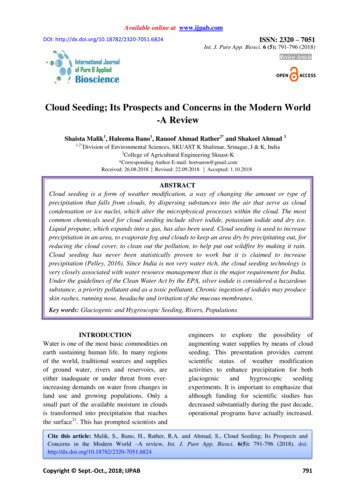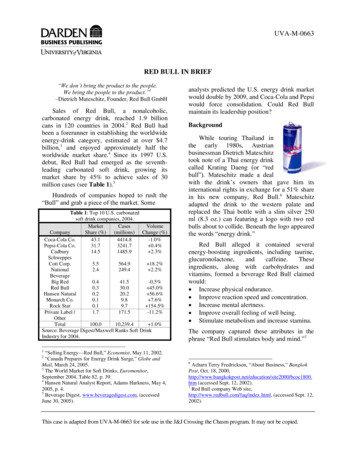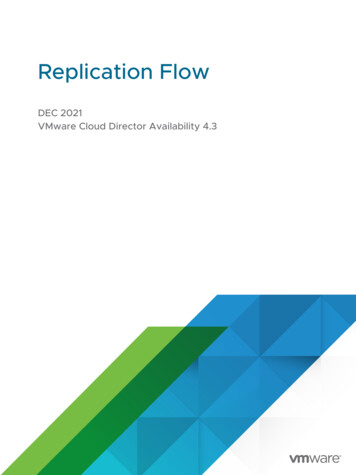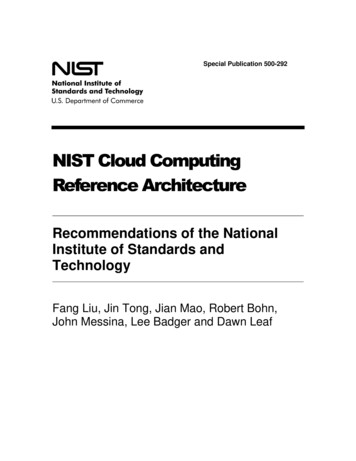
Transcription
Available online at www.ijpab.comMalik et alInt. J. Pure App. Biosci. 6 (5): 791-796 (2018)ISSN: 2320 – 7051DOI: http://dx.doi.org/10.18782/2320-7051.6824ISSN: 2320 – 7051Int. J. Pure App. Biosci. 6 (5): 791-796 (2018)Review ArticleCloud Seeding; Its Prospects and Concerns in the Modern World-A ReviewShaista Malik1, Haleema Bano1, Rauoof Ahmad Rather2* and Shakeel Ahmad 31,2*Division of Environmental Sciences, SKUAST K Shalimar, Srinagar, J & K, India3College of Agricultural Engineering Skuast-K*Corresponding Author E-mail: hortsuren@gmail.comReceived: 26.08.2018 Revised: 22.09.2018 Accepted: 1.10.2018ABSTRACTCloud seeding is a form of weather modification, a way of changing the amount or type ofprecipitation that falls from clouds, by dispersing substances into the air that serve as cloudcondensation or ice nuclei, which alter the microphysical processes within the cloud. The mostcommon chemicals used for cloud seeding include silver iodide, potassium iodide and dry ice.Liquid propane, which expands into a gas, has also been used. Cloud seeding is used to increaseprecipitation in an area, to evaporate fog and clouds to keep an area dry by precipitating out, forreducing the cloud cover, to clean out the pollution, to help put out wildfire by making it rain.Cloud seeding has never been statistically proven to work but it is claimed to increaseprecipitation (Pelley, 2016). Since India is not very water rich, the cloud seeding technology isvery closely associated with water resource management that is the major requirement for India.Under the guidelines of the Clean Water Act by the EPA, silver iodide is considered a hazardoussubstance, a priority pollutant and as a toxic pollutant. Chronic ingestion of iodides may produceskin rashes, running nose, headache and irritation of the mucous membranes.Key words: Glaciogenic and Hygroscopic Seeding, Rivers, PopulationsINTRODUCTIONWater is one of the most basic commodities onearth sustaining human life. In many regionsof the world, traditional sources and suppliesof ground water, rivers and reservoirs, areeither inadequate or under threat from everincreasing demands on water from changes inland use and growing populations. Only asmall part of the available moisture in cloudsis transformed into precipitation that reachesthe surface21. This has prompted scientists andengineers to explore the possibility ofaugmenting water supplies by means of cloudseeding. This presentation provides currentscientific status of weather modificationactivities to enhance precipitation for bothglaciogenicandhygroscopicseedingexperiments. It is important to emphasize thatalthough funding for scientific studies hasdecreased substantially during the past decade,operational programs have actually increased.Cite this article: Malik, S., Bano, H., Rather, R.A. and Ahmad, S., Cloud Seeding; Its Prospects andConcerns in the Modern World –A review, Int. J. Pure App. Biosci. 6(5): 791-796 (2018). ight Sept.-Oct., 2018; IJPAB791
Malik et alInt. J. Pure App. Biosci. 6 (5): 791-796 (2018)During the last 10 years there has been athorough scrutiny of past experimentsinvolving experiments using glaciogenicseeding. Although there still exists indicationsthat seeding can increase precipitation, anumber of recent studies have questionedmany of the positive results, weakening thescientific credibility. As a result, considerableskepticism exists as to whether these methodsprovide a cost-effective means for increasingprecipitation for water resources. Recentresults from hygroscopic seeding experimentsprovided for some renewed optimism in thefield of precipitation enhancement. Althoughpromising results have been obtained to date,some fundamental questions remain that needto be answered in order to provide a soundscientific basis for this technology.Methodology of Cloud Seeding:A rainstorm occurs after moisture collectsaround naturally occurring particles in the airlike dust sand, causing the air to reach a levelof saturation point at which it can no longerhold in that moisture and droplets fall in theform of rain. Cloud seeding essentially helpsthat process along, providing additional"nuclei" around which water droplet can resideand condensation occurs. These nuclei can besalts, dry ice or silver iodide. The mostcommon chemicals used for cloud seedinginclude silver iodide, potassium iodide and dryice (solid carbon dioxide). Liquid propane,which expands into a gas, has also been used.This can produce ice crystals at highertemperatures than silver iodide. Afterpromisingresearch,theuseof hygroscopic materials, such as table salt, isbecoming more popular. During cloudseeding, increased snowfall takes place whentemperatures within the clouds are between 19and 4 F ( 7 and 20 C). Introduction of asubstance such as silver iodide, which hasa crystalline structure similar to that of ice,will induce freezing nucleation. There arethree methods by which cloud seeding is done: Static cloud seeding Dynamic cloud seeding Hygroscopic cloud seedingCopyright Sept.-Oct., 2018; IJPABISSN: 2320 – 7051Static Method:This method involves spreading a chemicallike silver iodide into clouds. The silver iodideprovides a crystal around which moisture cancondense. The moisture is already present inthe clouds, but silver iodide essentially makesrain clouds more effective at dispensing theirwater. Physical studies and inferences drawnfrom statistical seeding experiments suggestthat there exists more limited window ofopportunity for precipitation enhancement bythe static mode of cloud seeding thanoriginally thought. The window of opportunityfor cloud seeding appears to be limited to thestatic mode of cloud seeding has been shownto cause the expected alterations in s of ice crystals, reductions ofsuper cooled liquid water content, and morerapid production of precipitation elements inboth cumuli3 and orographic clouds;(1) Clouds those are relatively cold-based andcontinental;(2) Clouds having top temperatures in therange —10 C to —25 C;3) A timescale limited by the availability ofsignificant super cooled water before depletionby entrainment and natural precipitationprocesses.This limited scope of opportunities for rainfallenhancement by the static mode of cloudseeding that has emerged in recent years mayexplain why some cloud seeding experimentshave been successful while others have yieldedinferred reductions in rainfall from seededclouds or no effect. A successful experiment inone region does not guarantee that seeding inanother region will be successful unless allenvironmental conditions are replicated aswell as the methodology of seeding.Dynamic Cloud Seeding:Dynamic cloud seeding aims to boost verticalair currents, which encourages more water topass through the clouds, translating into morerain. Up to 100 times more ice crystals areused in dynamic cloud seeding than in thestatic method. The process is considered morecomplex than static clouding seeding becauseit depends on a sequence of events working792
Malik et alInt. J. Pure App. Biosci. 6 (5): 791-796 (2018)properly. Dr. William R. Cotton, a professor ofatmospheric science at Colorado StateUniversity, and other researchers break downdynamic cloud seeding into 11 separate stages.An unexpected outcome in one stage couldruin the entire process, making the techniqueless dependable than static cloud seeding.Hygroscopic Cloud Seeding:The term ―hygroscopic seeding‖ has beenassociated with warm cloud seeding. Theobjective is to enhance rainfall by promotingthe coalescence process using hygroscopic saltnuclei generated by pyrotechnic flare or a finespray of highly concentrated salt solution. Inaddition, Cooper et al.4 illustrated thathygroscopic seeding might have a beneficialeffect on precipitation development througheither of two distinct mechanisms:(i)Introduction of embryos on whichraindrops form.(ii)Broadening of the initial droplet sizedistribution resulting in acceleration ofall stages of the coalescence process.In 1990, G. Mather reported a case ofinadvertent seeding of clouds by hygroscopicparticles emitted from Kraft Mill in SouthAfrica that resulted in enhanced coalescenceand rainfall. This observation led to furtherhygroscopic cloud seeding experiments inSouth Africa,4, 9, Thailand18, Mexico1 and Indiawith highly encouraging results. Additionalexperiments have been conducted morerecently in Texas using powdered salt havingparticle diameters of 2 to 5 microns.Indian History of Cloud SeedingIn India, pioneering attempts in the field ofrainmaking were made by Tata firm in 1951over Western Ghats using ground based silveriodide generators. Dr. Banerji in the year 1952attempted cloud seeding with salt and silveriodide by means of hydrogen filled balloonsreleased from the ground. The committee onthe Atmospheric Research of the Council forScientific and Industrial Research (CSIR)recommended in 1953 that a rain and CloudPhysics Research (RCPR) unit be set up forundertaking extensive scientific studies oncloud physics and rainmaking. RCPRconducted long term cloud seeding programmeCopyright Sept.-Oct., 2018; IJPABISSN: 2320 – 7051over north India using ground based saltgenerators during the period 1957-1966. Theresults showed an increase in rainfall by 20%11. RCPR later became part of IITM. IITMconducted similar experiments over Tiruvallur(state of Tamilnadu), during 1973, 1975-1977.The seeding experiments were also done overMumbai in the monsoon seasons 1973 and1974 5. In the same years IITM carried outcloud seeding operations over Rihand 4catchment in the state of Uttar Pradesh. In1975, operational programme of cloud seedingwas conducted over Linganamakki catchmentarea in the state of Karnataka. These programswere operational; hence their effect in increasein rainfall could not be assessed. IITM carriedout cloud seeding experiment over Baramatiregion of the Maharashtra state during theperiod 1973-74, 1976, and 1979-86. Theresults showed 24% increase in the rainfall10.Need of cloud seeding:Drought in India is a regular event occurringalmost every year in some Indian states.Because droughts are a normal part of virtuallyany climate, it is important to develop plans toreduce their impacts. However, Droughtdeclaration and response management in Indiahave always been a large and complexoperation, requiring close, often challengingand co ordination between various governmentlevels. It has been observed that affected ruralcommunities suffer from scarcity of drinkingwater, non-availability of fodder for cattle,migration along with families, and increasedindebtedness. Each of these situations has anegative impact on education, nutrition, health,sanitation and the care and protection ofchildren. Drought has resulted in tens ofmillions of deaths over the course of the 18th,19th, and 20th centuries in India. Indianagriculture is heavily dependent on the climateofIndia:afavorablesouthwestsummer monsoon is critical in securing waterfor irrigating Indian crops. In some parts ofIndia, the failure of the monsoons result inwater shortages, resulting in below-averagecrop yields. This is particularly true of majordrought-prone regions such as southern andeastern Maharashtra, Karnataka,Andhra793
Malik et alInt. J. Pure App. Biosci. 6 (5): 791-796 (2018)Pradesh, Gujarat, Odissa, Telangana andRajasthan19.Meteorological drought adverselyaffects the recharge of soil moisture, surfacerunoff and ground water table. Soils dry up,surface runoff is reduced and ground waterlevel is lowered. Rivers, lakes, ponds andreservoirs tend to dry up wells and tube-wellsare rendered unserviceable due to lowering ofthe ground water table. Indian agriculture stilllargely depends upon monsoon rainfall whereabout two-thirds of the arable land lackirrigation facilities and is termed as rain fed.The effect is manifested in the shortfalls ofagricultural production in drought years.Social and economic impact of a drought ismore severe than the physical and agriculturalimpacts. A drought is almost invariablyassociated with famine which has its ownsocial and economic consequences. The totaldrought-prone area in India amounts to 10.7lakh square kilometers. On an average, one inevery five years is a drought year.Water covers 70% of our planet, and itis easy to think that it will always be plentiful.However, freshwater we drink, bath in, andirrigate our farm fields is incredibly rare. Only3% of the world’s water is fresh water, andtwo-thirds of that is tucked away in frozenglaciers or otherwise unavailable for our use.As a result, some 1.1 billion people worldwidelack access to water, and a total of 2.7 billionfind water scarce for at least one month of theyear. Inadequate sanitation is also a problemfor 2.4 billion people—they are exposed todiseases, such as cholera and typhoid fever,and other water-borne illnesses. Two millionpeople, mostly children, die each year fromdiarrheal diseases alone16.Many of the water systems that keepecosystems thriving and feed a growing humanpopulation have become stressed. Rivers, lakesand aquifers are drying up or becoming toopolluted to use. More than half the world’swetlands have disappeared. Agricultureconsumes more water than any other sourceand wastes much of that throughinefficiencies. Climate change is alteringpatterns of weather and water around theCopyright Sept.-Oct., 2018; IJPABISSN: 2320 – 7051world, causing shortages and droughts in someareas and floods in others. At the currentconsumption rate, this situation will only getworse. By 2025, two-thirds of the world’spopulation may face water shortages. Andecosystems around the world will suffer evenmore17.The Himalayan state of Jammu andKashmir receives 30% of its annual rainfall inthe winter. Several studies indicate that mostparts of the Himalayas are getting warmer at arate faster than the average warming of theearth. Patterns of rain and snow varythroughout the mountains as weather iscontrolled by dramatic changes in topographyand the presence of distinct microclimates inmany parts. Climate change also magnifiesintense weather making it more destructive.―When weather conditions are leading to avery heavy event, even a 10% boost of thatbecause of climate change could be extremelydamaging and could lead to a disaster,‖In the run-up to the 2008 Olympics inBeijing, more specifically the openingceremony, and the Chinese government openlyoperated their cloud seeding program so thatthe first day of the Olympic Games would notbe marred by rain or any other unsavoryweather. Over 1,000 rockets were fired into theair in the days leading up to the ceremony inan effort to disperse rain clouds that werethreatening to dampen the event.The Government of Andhra Pradeshhas declared nearly 555 Mandals under RainShadow in the year 2005. Cloud seeding wasdone from 2004-2009.Farmers have beeninstructed to dial a helpline if they sight cloudsthat appear to be rain-bearing, so that themoisture can immediately be precipitatedthrough aerial seeding. Two aircraft loadedwith flares were equipped to take off at amoment's notice to seed the clouds. CloudSeeding was effective in Ananthapur,Cuddapah, Kurnool, Mahbubnagar, Nalgondaand Ranga Reddy districts.ADVANTAGES OF CLOUD SEEDING:1. Creates Rain:Where rain is badly needed, cloud seeding isperhaps the only way to produce rain. People794
Malik et alInt. J. Pure App. Biosci. 6 (5): 791-796 (2018)use silver iodine to induce rain production inareas where there is barely any precipitation.Rain is important for keeping the areahydrated and fertile for growing crops andother plants.2. Boosts Economy:Where there is rain, there is farm produce.Farms that yield better can help the localeconomy and feed the people (and evenanimals). Cloud seeding can greatly improvethe living conditions in dry, arid places.3. Regulates Weather:Cloud seeding in a way, gives us the ability tocontrol the weather condition in a particulararea. It does not just make rain; it alsoregulates water vapor that in turn preventsdamages brought by destructive hails andstorms.4. Makes Dry Places More Livable:Local people have an impressive way ofadapting to their natural environment. Butinhospitable places rarely visited by rain canbe inhospitable to tourists and foreigners.Cloud seeding can make such places livable.DISADVANTAGES:1. RequiresPotentiallyHarmfulChemicals:Chemicals used in cloud seeding canpotentiallydamagetheenvironment,especially the plants cloud seeding is intendedto protect. There is no substantial study doneon the implications of silver iodine on theenvironment. Silver iodine may cause―iodism,‖ a type of iodine poisoning where thepatient exhibits running nose, headache, skinrash, anemia, and diarrhea, among others. Ithas been found to be highly toxic to fish,livestock and humans.2. Is Not Fool proof:Cloud seeding requires rainclouds. It cannotwork on just any other cloud formations. Also,seeded clouds may actually travel to anotherlocation and do not cause precipitation on theintended location. Therefore, it can be arguedwhether or not cloud seeding is truly effectivein producing rain.3. Costs a Lot:It is very expensive to produce artificial rain.The chemicals have to be delivered to the airCopyright Sept.-Oct., 2018; IJPABISSN: 2320 – 7051via planes, which are hard to come by inplaces with very minimal income. Povertystricken areas suffering drought or famine mayneed external funding to have cloud seeding.4. Poses Weather Problems:If not regulated or controlled properly, cloudseeding may cause undesirable if notaltogether destructive weather conditions suchas flooding, storms, hail risks, etc. Places thatnaturally do not get much rain or no rain at allusually do not have the infrastructure to handleso much precipitation. With cloud seeding,these areas may become flooded quickly,causing more harm than good. CONCLUSIONMore the water resource of a nation thehigher will be the opportunities forachieving high rates of progress inagriculture sector and industrial growthIndian water resources are declining andIndia is going to be water stressed countrytill 2025.16 percent of total area is drought proneand farmers are committing suicide socloud seeding becomes the necessity totackle this critical situation.The cloud seeding technology is veryclosely associated with water resourcemanagement - major requirement forIndia.REFERENCES1. Bruintjes, R. T., Breed, D. W., Salazar, V.,Dixon, M. J., Kane, T. Foote, G. B. andBrown. B. G., Overview and results fromtheMexicanhygroscopicseedingexperiment. Technical document providedby author (2001).2. Christner, B. C., Morris, C. E., Foreman,C. M., Cai, R. and Sands, D. C., Ubiquityof biological ice nucleators in snowfall.Science. 319(5867): 1214 (2008).3. Cooper, W. A., and Lawson. R. P.,Physical interpretation of results from theHIPLEX-1 experiment. Journal of climateand Applied Meteorology 23(4): 523-540(1984).795
Malik et alInt. J. Pure App. Biosci. 6 (5): 791-796 (2018)4. Cooper, W. A., Bruintjes, R. T. andMather, G. K., Calculations pertaining tohygroscopic seeding with flares. Journalof Applied Meteorology 36(11): 14491469 (1997).5. Czys, R. R. and Bruintjes, R., A review ofhygroscopic seeding experiments toenhance rainfall. The Journal of WeatherModification, 26(1): 41-52 (1994).6. Hill, S. A. and Yi, M., Nonlinear climateresponse to regional brightening oftropicalmarinestratocumulus.Geophysical Research Letters 39: L15707(2012).7. IndianMeteorologicalDepartment,Ministry of Earth Sciences Government ofIndia, (2016).8. Klein, D. A., Environmental impacts ofartificial ice nucleating agents, Dowden,Hutchinson and Ross, Inc., Stroudsburg,pp 256 (1978).9. Mather, G. K, Terblanche, D. E, Steffens,F. E. and Fletcher, L., Results of the SouthAfrican Cloud-Seeding Experiments UsingHygroscopic Flares. Journal of AppliedMeteorology 36: 1433-1447 (1997).10. Murty, and Ramachandra, A. S., SaltSeeding from Aircraft over LinganamakkiCatchment, South India. The Journal ofWeather Modification 13(1): 167-173(2012).11. Murty, Ramana, B. V. and Biswas, K. R.,Weather modification in India. Journal oftheMeteorologicalSocietyofJapan. 46(3): 160-165 (1968).12. Patel, N. R., Chopra, P. and Dadhwal, V.K., Analyzing spatial patterns ofmeteorological drought using standardizedprecipitationindex. MeteorologicalApplications 14(4): 329-336 (2007).Copyright Sept.-Oct., 2018; IJPABISSN: 2320 – 705113. Pelley, J., Does cloud seeding really work?. Chemical and Engineering News.94(22): 18-21 (2016).14. Prantl, J. Why we need a debate about Geoengineering Governance. (2011).15. Roelof, T. B., A review of cloud seedingexperiments to enhance precipitation andsome new prospects. National Center forAtmospheric Research 80(5): 805-820(1999).16. Rothfeder, J., Every drop for sale: Ourdesperate battle over water in a worldabout to run out. Penguin (2004).17. Seckler, D., Barker, R., and Amarasinghe,U., Water scarcity in the twenty-firstcentury. International Journal of WaterResources Development 15(1-2): 29-42(1999).18. Silverman, B. A., and Sukarnjanaset W.,Results of the Thailand warm-cloudhygroscopicparticleseedingexperiment. JournalofAppliedMeteorology 39(7): 1160-1175 (2000).19. Singh,M.B.,Fotedar,R.,Lakshminarayana, J. and Anand, P. K.,Studies on the nutritional status of childrenaged 0–5 years in a drought-affected desertarea of western Rajasthan, India. Publichealth nutrition 9(8): 961-967 (2006).20. Tremback, C. J., Walter, A. L., William P.T and Robert L. W., An emergencyresponse and local weather forecastingsoftware system: Air Pollution Modelingand Its Application Springer, Boston, MA10: 423-429 (1994).21. Weather Modification Advisory Board,The management of weather resources,Volume I, proposals for a national policyand program. Report to the Secretary ofCommerce, Washington, DC (1978).796
dynamic cloud seeding into 11 separate stages. An unexpected outcome in one stage could ruin the entire process, making the technique less dependable than static cloud seeding. Hygroscopic Cloud Seeding: The term ―hygroscopic seeding‖ has been associated with warm cloud seeding. The objective is to enhance rainfall by promoting










